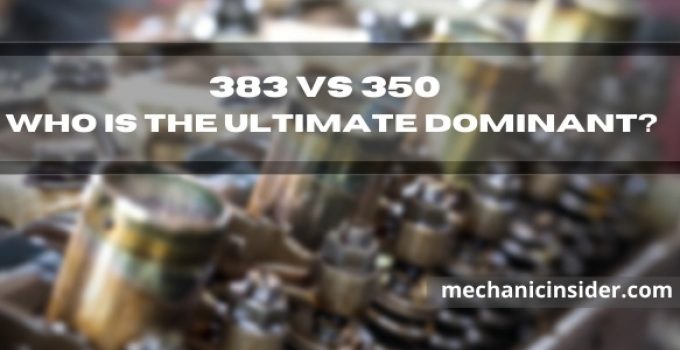The Chevrolet or Chevvy Small-block engine is a sequence of V8 motorcar engines that were used in general production by the Chevrolet sector of General Motors. We can even say that this series of small-block engines had changed the face of automobile engine history.
After the debut of the small-block engine in 1955, this technologically advanced and innovatively designed SBC vastly influenced the future V8 engine designs. And over the years, different combinations of the small-block V8 engines have been used in off-road trucks, race cars, custom motorcycles, and even boats.
This engine is sought after for its quiet operation, performance, and its durability. One of the biggest reasons for the small-block engine to be so popular is its ability to interchange.
This means that the small-block engines can swap its parts no matter the make-year difference. For example, we can set up a set of heads onto the 1955 Chevy 265 engine from a 1990 Vortec truck engine.
As an enthusiast, we’re going to tour you through the basics first & then there comes the comparison part. If you just wanna know the comparison, scroll down , you’re there!
But we recommend you to know the basics first.
Chevy 350 Engine
Among the small block engines, the Chevy 350 engine is considered to be one of the best engines of the 20th century. And it was not that long time ago when the 350 engines had some serious street cred. Even in a debate of Chevy 400 vs. 350, the SBC 400 stroker did not come out as the winner.
All types of Chevrolet V8s, including the Chevvy 350, evolved from the 265 cubic inches of the small-block family. And followed by this came the 4.000-inch bore family that was initially intended to be the performance block. It was later rendered as the all-performance engine that could be found from classic Chevrolets to radical Jeep conversions.
chevy 350 engine specs
Commonly known as the Chevvy 350 engine, the GM 5.7L V8 engine uses 4 inches bore and has a stroke of 3.48 inches. This engine uses a wet-sump system and has a 4.73-liter oil pan. The pistons are manufactured from either forged aluminum or cast aluminum and have a compression height of 1.46 inches. The connecting rods are made of forged steel and are 5.7 inches in reach.
Types
L-48: Produced 1967, the 350 engines first appeared as a high performing L-48 option solely for the SS Camaro or the Chevy II/Nova during 1968-1969. In 1969, this version was used for almost all car lines. It had a power output of 300 HP and 380 lb./ft torque
L-46: The L-46 was an open option for the 1969 Chevrolet Corvette Stingray. It had a higher performance than the base 350cu with a compression rate of 11.0:1 and producing 350 HP. It required high octane gas to run.
ZQ-3: The ZQ-3 was used as the standard engine in the 1969-1974 Chevrolet Corvette. Initially, it had a horsepower of 300 HP, which decreased 270 HP when reducing its compression rate from the initial from 10.25:1 to 8.5:1.
LS-9: The LS-9 was a 350 cubic inch truck engine that was used in C/K/G 10/20 models that weighed under 8,500 lbs. It used a 4-bbl. carburetor of Rochester, and it had a horsepower of 165 at 3800 RPM. Its torque was measured at 275 lb./ft at 1600 RPM.
L-65: The 1970 Camaro used this high-performance engine with 250 HP. It used a 2 bbl. Rochester carburetor. It had a torque of 255 lb./ft.
LT-1: Released in 1970. the LT-1 was known as the ultimate 350 cubic inches V8. Using solid lifters, it had a compression rate of 11.0:1 with its highest horsepower being 370.
L-82: L-82 was the performance version of the 350 engines, which used a hydraulic-lifer cam with a compression ratio of 9.0:1. It had a horsepower of 250 HP.
LM-1: It is the base 350 cubic inches with a 4-barrel carburetor. It had a mechanical ignition point along with a computer-controlled spark system. It had 190 HP, and its compression ratio was 8.2:1.
L-98: Produced in 1985, the L-98 represented the successful metamorphosis of the 350s into a fuel-efficient, emissions-friendly engine. Its compression rate varied between 9.0:1 to 10.0:1. It had a horsepower of 230 HP to 250 HP. It added the tuned-port fuel injection or TPI.
L-31: Produced in 2002, this is the last production of Chevrolet’s Generation I. The L-31 head is compatible with the previous small-blocks, and thus it is a trendy upgrade. It has a horsepower of 255.
Chevy 383 Stroker
Just as the small-block Chevvy is known to be the most predominant powerhouse in the world of muscle cars, the 383 can very well be considered as the most popular displacement.
If we machine the prime journals of a 400 cubic inches small-block crankshaft and fit it in a 350 block, the more extended arm will add roughly 28 cubic inches to a bore of 4.030 small-block Chevvy. This results in an engine displacement of 382.6 or approximately 383.
One may ask why we are not building an SBC 400 stroker in the first place. Initially, it was thought that 400 SBC was prone to overheat, so they stuck to the 350. Now, 400ci standard-bores are hard to find, so we are going for the 383 in the 400 SBC Vs. 383 stroker.
CHEVY 383 Specs
The stroker 383 has a stroke of 3.75 inches and a bore of 4.03 inches. The engine block is required to be bored over 0.030 its original size for proper displacement and proper clearance. Without adequate clearance, the longer stroke of the small block 400 crankshafts would severely wear out the cylinders and rods.
Chevvy 350 vs. 383 stroker
Now that we know about both the Chevvy 350 and the 383 stroker Chevy and their specifications, we can finally discuss whether to choose the Chevy 350 or the 383 Chevy stroker.
350 Vs. 383 – the much anticipated comparison
Let us compare the cold, hard facts between the two engines.
Stroke Length
While the Chevy 383 stroker motor has a stroke with a length of 3.75 inches, the 350 has that of 3.48 inches.
Bore
The 383 stroker engine has a bore of 4.03 inches, whereas the Chevy 350 has that of 4.00 inches.
Engine Displacement
The engine displacement is usually referred to in cubic inches. There is a formula for measuring the engine displacement.
The formula is pie (3.1415927)/4*bore^2*stroke length*number of barrels.
Using this formula and the information available, we can find the Chevy 350’s engine displacement to be 349.84 or rounding up 350 cubic inches.
On the other hand, the 383 stroker crate engines generally have an engine displacement of 382.668 or rounding it up to 383 cubic inches.
383 vs 350 – Which should we choose?
We should definitely go for the stroker 383 engine. Now we are going to discuss why we should choose this engine stroker.
Engine Displacement
As we already know, the Chevy 383 stroker engine has more engine displacement than the stock Chevy 350. The 383 stroker crate engine has an engine displacement of 383 cubic inches compared to the 350 engines, which has that of 350 cubic inches.
This means that the 383 stroker build can draw 383 cubic inches of air and fuel per cycle while maintaining low RPM, which is excellent for daily use because let us face it, when was the last time we cranked our motor up to 8000!
This more massive displacement will make the optimum use of the intake manifolds, heads, or any induction enhancing components or exhaust.
Even if we are in a system restricted-smog-emissions fuel-injection, we can still make comparatively more power as more cubic inches are available.
Length of Stroke
The 383 Chevy stroker has a longer stroke than that of the Chevy 350. This increased stroke gives us a larger leverage arm, which allows the fuel combustion to apply an increased amount of pressure to the flywheel while using the same amount of fuel.
In turn, the increased stroke increases the piston speed, which compels the stroker to pull more air while keeping a lower engine RPM.
The piston speed increase also helps the piston act on the combustion chamber’s quench area at a more incredible speed, which increases the combustion chamber’s efficiency.
With the rise in the combustion chamber’s efficiency, the engine can make all its power at a lower RPM.
Fuel Efficiency
The 383 stroker has a better low-end throttle response and more torque. Which gives us better mile-per-gallon statistics.
Besides, the 350 engines were less economical in terms of fuel and sometimes even needed premium gas or high octane to run
Besides all these reasons, several 383 stroker kits are available in the market for a low price. We can buy a fully machined, brand-new stroker 383 kits for even less than 200$ now!
So, if we want to build a 383 stroker, we can always do it ourselves. Or, we can take the help of the professionals for building a 383 stroker.
Final Thoughts
In the debate between the Chevy 350 and the stroker 383, we & substantially other moto experts lean in the latter’s direction. Aside from the various facts, because of the 383 stroker hp being higher than the 350, it is also comparatively more exciting to drive it. We also have the option to make 383 the stroker 500 HP, which we should add, will be a bit more costly than the base version. Now that we have chosen to build the 383 strokers, either for its efficiency or the variation of 350 to 383 stroker horsepower, we should use the best cam for the 383 strokers and machine the internal parts properly.



